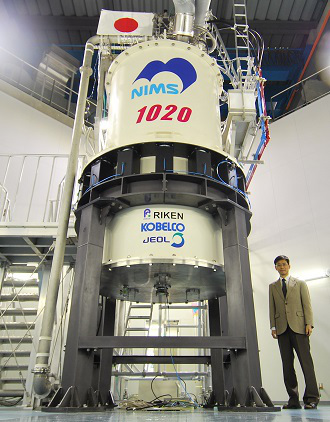World’s Highest Magnetic Field* (1,020MHz) NMR developed

Photo: A part of the recently developed 1,020 MHz-NMR system equipped with superconducting magnets (about 5 m high and weighing about 15 tons). This part contains coils made of a high-temperature superconductor. Liquid helium is used for cooling. Copyright : NIMS
The research team of Japan's National Institute for Materials Science (NIMS), RIKEN, Kobe Steel and JEOL RESONANCE successfully developed the NMR system equipped with world’s highest magnetic field, 1,020 MHz, supported by the JST-SENTAN program “Development of Systems and Technology for Advanced Measurement and Analysis”.
This research result was published in Journal of Magnetic Resonance on 15 May 2015 (Kenjiro Hashi, Shinobu Ohki, Shinji Matsumoto, Gen Nishijima, Atsushi Goto, Kenzo Deguchi, Kazuhiko Yamada, Takashi Noguchi, Shuji Sakai, Masato Takahashi, Yoshinori Yanagisawa, Seiya Iguchi, Toshio Yamazaki, Hideaki Maeda, Ryoji Tanaka, Takahiro Nemoto, Hiroto Suematsu, Takashi Miki, Kazuyoshi Saito and Tadashi Shimizu, Title:”Achievement of 1,020 MHz NMR”, DOI:10.1016/j.jmr.2015.04.009).
The research team consisting of researchers at NIMS, RIKEN, Kobe Steel and JEOL RESONANCE (a consolidated subsidiary company of JEOL) successfully developed the NMR (nuclear magnetic resonance) system equipped with world’s highest magnetic field, 1,020 MHz, during engagement in the JST-SENTAN program “Development of Systems and Technology for Advanced Measurement and Analysis”. In addition, taking actual measurements with this new system, the team confirmed its considerably enhanced performance compared to conventional NMR systems in terms of sensitivity and resolution.
NMR systems have been used for various purposes including 3D conformational analysis of biopolymers such as proteins, organic chemistry and materials research. In particular, it is one of the indispensable tools for the development of new drugs. In the development of a new drug, it is vital to understand protein structures in a quick and accurate manner.
In this view, improving the performance of NMR systems is of great importance. Magnetic field strength is a key indicator of the performance of NMR systems, and thus there had been fierce competition to develop NMR systems with magnetic fields greater than 1,000 MHz. For a long time, it was broadly expected that the use of high-temperature superconducting technology would enable producing magnetic fields above 1,000 MHz. However, because high-temperature superconductors had problems such as being fragile and difficult to process, no party had achieved their practical use for a long run.
Through developing several new technologies including the conversion of the high-temperature superconductor developed by NIMS in 1988 into the form of wire material, the research team recently created the NMR system equipped with world’s highest magnetic field at 1,020 MHz.
Before making this accomplishment, the team spent 20 years of planning, designing and construction, as well as overcoming many hardships such as suspension of the project due to the damage to the nearly completed system caused by the Great East Japan Earthquake, encountering a serious worldwide shortage of helium supply, and the sudden passing of the team leader.
It is expected that the super-high magnetic field NMR will greatly contribute to various fields such as structural biology, analytical chemistry and materials engineering. Furthermore, considering that NMR requires a magnetic field with extraordinary precision, the high-temperature superconducting technology that was cultivated during the development of NMR is applicable to various high-tech systems such as MRI (magnetic resonance imaging), nuclear fusion, linear motor trains and superconducting power cables.
A part of this study was published in the Journal of Magnetic Resonance on May 15, 2015, and was presented at the Experimental Nuclear Magnetic Resonance Conference, the largest international conference on NMR, held from April 19 to 24 in the United States, and at the 57th Solid-State NMR and Materials Forum held on May 21, 2015 in Japan.
*World’s Highest Magnetic Field: 1020MHz (24.0T) As of Apr 17, 2015
Associated links
NIMS article
Media Contact
More Information:
http://www.researchsea.comAll latest news from the category: Materials Sciences
Materials management deals with the research, development, manufacturing and processing of raw and industrial materials. Key aspects here are biological and medical issues, which play an increasingly important role in this field.
innovations-report offers in-depth articles related to the development and application of materials and the structure and properties of new materials.
Newest articles

Silicon Carbide Innovation Alliance to drive industrial-scale semiconductor work
Known for its ability to withstand extreme environments and high voltages, silicon carbide (SiC) is a semiconducting material made up of silicon and carbon atoms arranged into crystals that is…

New SPECT/CT technique shows impressive biomarker identification
…offers increased access for prostate cancer patients. A novel SPECT/CT acquisition method can accurately detect radiopharmaceutical biodistribution in a convenient manner for prostate cancer patients, opening the door for more…

How 3D printers can give robots a soft touch
Soft skin coverings and touch sensors have emerged as a promising feature for robots that are both safer and more intuitive for human interaction, but they are expensive and difficult…





















